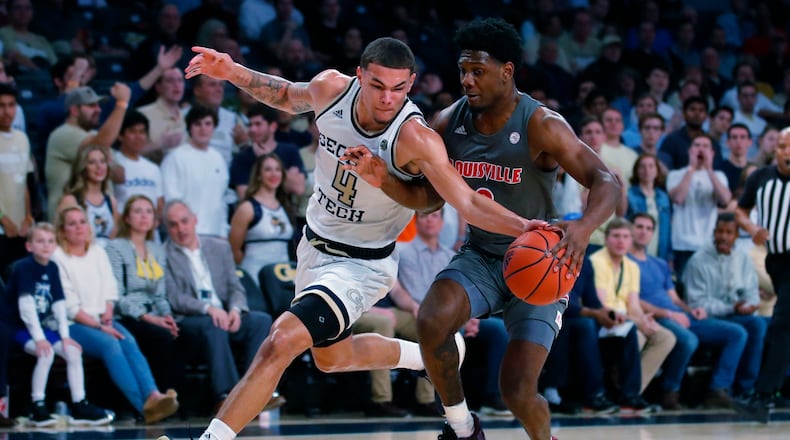Josh Pastner knows it’s unorthodox. The Georgia Tech coach even used the word “kindergarten-ish” to describe the way he waves laminated cards from the sideline to signal the defense that he wants his team to run.
He’s not aware of any other teams that use a similar communication system, but Tech relies on it because of its simplicity.
“My objective is to make sure there’s no gray area,” Pastner said.
In his fourth season, and particularly in recent games, the system is working, with no small amount of credit due its practitioners. Tech will play at Wake Forest on Wednesday night having put together some of its better defensive performances of the season in recent games.
While the 1-3-1 zone has been a staple in Pastner’s four seasons, the Yellow Jackets have used a man-to-man defense much more frequently this season than they did last season.
“We’ve done a nice job recently in man-to-man,” Pastner said. “But you look at, like, Virginia Tech, we played pretty much the whole game zone, and we were really good. Louisville, we played pretty much all man. North Carolina State, we were all over the place. It just kind of varies on how the things have gone.”
Tech won all three games, each time holding the opponent to under 40% shooting from the field. (In that time frame, Notre Dame and Pitt also beat the Jackets by shooting above 40%.)
It’s an important threshold. In Pastner’s tenure, the Jackets are 20-7 in regular-season ACC games when holding teams under 40% from the field, according to the website Sports Reference.
But the Jackets’ success with multiple defenses puts a spotlight on the Tech players executing them. The wins would seem to be products of effort and execution more than scheme.
“We’ve got a lot of guys that can really defend,” guard Michael Devoe said. “(Which defense is used) just depends on the games and how it’s going.”
Pastner declined to say the number of schemes he will put to use – he allowed that it’s not more than five – but acknowledged that the 1-3-1 zone and the man defense are the primary defenses. The zone has been Tech’s defensive hallmark, and the fact that the Jackets are rarities in using its intricate 1-3-1 has provided an advantage, as has the occasional shift back to the traditional man defense.
Pastner said that he has had opposing coaches tell him after games that they had worked throughout the offseason to prepare for the zone, only to have the Jackets defend them man-to-man. Or, Pastner said, colleagues have told him that “we have this man-play drawn up and you come out, and you’re in this other zone I’ve never even seen before.”
The mixture compels teams to prepare for multiple defenses, eating valuable practice time in the compressed ACC schedule.
“You’re not going to sit there for three hours (in practice),” Pastner said. “You just can’t. Especially at this time of the year.”
On the flip side, though, the Jackets themselves have to fine-tune multiple defenses during their own practices.
Pastner said that he has an idea of what defense he wants to throw at opponents, based on both the opposition and watching how his own team has handled the different schemes in practice.
“But then sometimes, as you know, I’m a feel guy, too, based on subbing and sometimes I just have a feel the way a play is working or a defense is working, and I’ll stick with that at times,” Pastner said. “So it just kind of depends on that.”
Credit: Curtis Compton
Credit: Curtis Compton
In recent weeks, Tech has spent more practice time preparing the defense, reverting to Pastner’s standard. Before that, as the coaching staff implemented a new offensive scheme and sought to minimize the turnover problem that has been afflicting the Jackets, the team devoted an atypically large portion of practice to offense.
The wins over N.C. State, Virginia Tech and Louisville may have been indicators of the success of the re-investment in defense. The then-No. 5 Cardinals shot 33.9% from the field and 12.5% from 3-point range as the Jackets pulled off a win over a top-five opponent for the first time since January 2016.
It’s been a display of Pastner’s defense-first approach that has defined his time at Tech. Going into Tuesday’s games, the Jackets were ranked 28th in defensive efficiency by KenPom. The Jackets have finished Pastner’s first three seasons ranked 61st or higher in that category.
With six regular-season games remaining, it’s possible – though hardly certain – that Pastner may have found the right balance of focus on offense and defense. At 12-13 overall and 6-8 in the ACC, there’s scant time to make those games meaningful.
Either way, Pastner will have his laminated cards lying on the Joel Coliseum scorer’s table, ready to be held aloft as his players retreat on defense, like a chauffeur driver in an airport terminal. The practice is perhaps emblematic of Pastner, a person who prefers practicality over flair. This is a man, after all, who made a practice of wearing the same striped Russell Athletic polo shirt because it was “easy and accessible.”
However unusual it is, he got the idea from mentor Lute Olson, the coaching legend at Arizona.
“And I’m 1/50th, 1/1000th, 1/millionth of a coach he is,” Pastner said. “But it worked for him.”
About the Author
Keep Reading
The Latest
Featured



